Table of Contents
Katharine Hepburn's star persona revolutionised Hollywood by enabling films centred on communities of women rather than male leads or romance.
The Bechdel Test had a significant impact on helping film viewers become aware of the lack of realistic female relationships on screen. It points out that not only are individual women not accurately represented, but that the way women interact with one another as friends, mothers, daughters, sisters, is almost completely ignored. Groups of men are represented in a slew of westerns, military, and sports films in which their primary subject of interest is not women. Yet movies like chick flicks, which do show groups of women, are more often than not focused on a romantic relationship with a man. This was equally true in classic Hollywood, the most obvious example being George Cukor’s fabulous all-female cast The Women (1939), in which all the characters ever talk about is men!
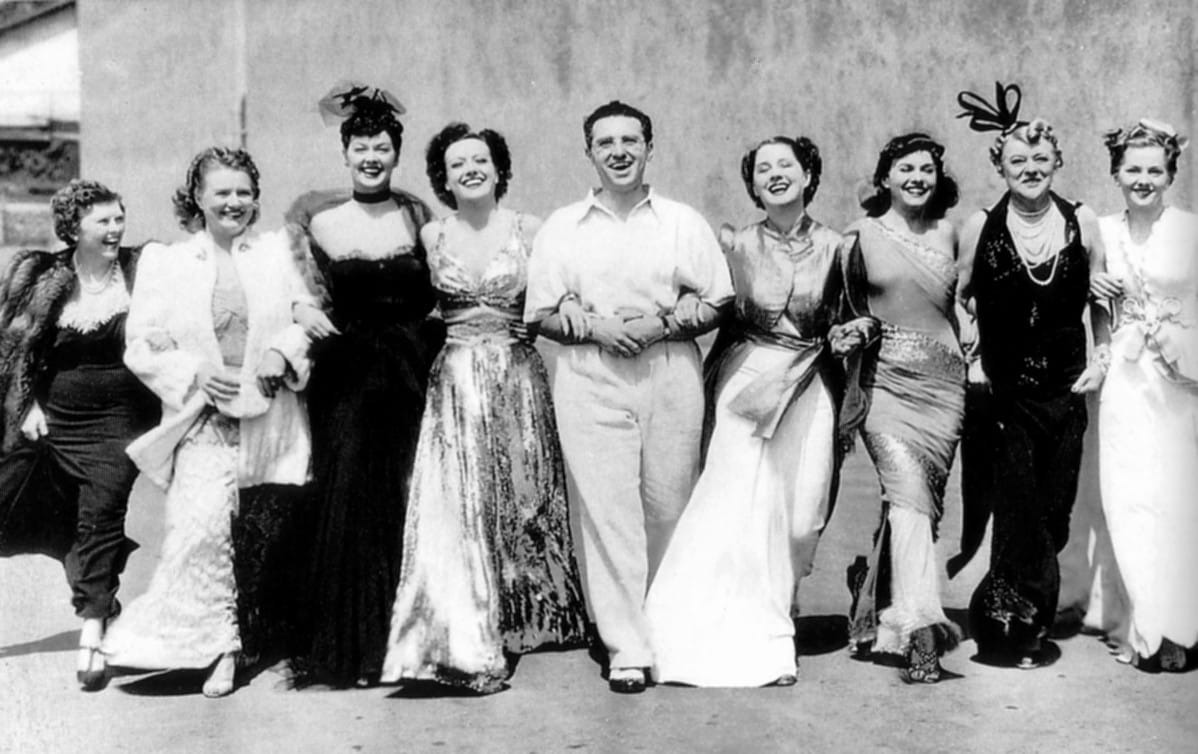
In the landscape of classic Hollywood cinema, few phenomena were as rare as films centring on groups of women whose relationships with one another drove the narrative forward. The concept of ‘communities of women’ represents a revolutionary approach to female representation in cinema, one that found its most powerful expression through the unique star persona of Katharine Hepburn. This analysis explores how Hepburn's ‘red-haired tempestuous genius’ persona enabled filmmakers to create a new type of cinema focused on autonomous female groups.
Understanding star persona and its radical potential
Janet Thumin's definition of ‘star persona’ as the ‘public image which derives from the performances and utterances of the person and is constructed over time in specific ways’ provides the foundation for understanding Hepburn's revolutionary impact on cinema. In Hepburn's case, this persona becomes inseparable from the film text itself, creating what we might call a ‘star text’ - the reading of the star persona within the context of the film.
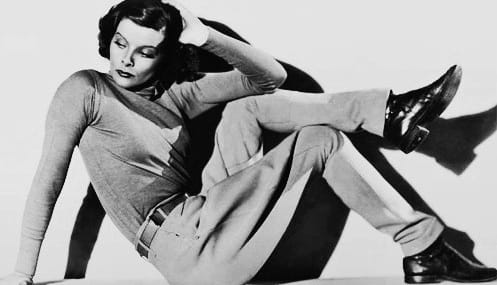
Andrew Britton argues that ‘Hepburn's presence is always more radical than her films’ and that this presence ‘forces her films to go in directions they cannot possibly follow, adopt strategies they cannot fully sustain, raise issues they cannot adequately resolve.’ However, this radical presence actually allows certain types of films to explore new directions that would be impossible without her star power.
The rarity of female-centred narratives in classic Hollywood
Classic Hollywood cinema rarely featured female groups leading the plot. Most films either featured single female protagonists defined in relation to male characters or relationships between two female protagonists that inevitably centred on rivalry over men. Britton observes that Hollywood films about female relatives typically show these characters ‘bound together in passionate, destructive resentment and animosity’ which is invariably generated by the women being rivals for a man and/or their embodiment of the 'good' (wifely, domesticated) and 'bad' (sexual) woman respectively.
However, Hepburn films present a striking difference. Britton identifies the female bond in these productions as an ‘oppositional unity in contradiction to that of the patriarchal family.’ These bonds are therefore ‘destroyed by the intervention of men,’ yet during their existence, they create something unprecedented in Hollywood cinema.
Hepburn's feminist foundation and star text
Hepburn epitomises what her mother's generation of feminists were striving for: an educated, opinionated, confident, independent, autonomous professional woman. First wave feminism provided the modern woman with the right to vote, as well as the right to better higher education and to birth control. What the first wave didn't establish was an equal footing with men in the workplace. However, although Katharine Hepburn's generation inherited an incomplete feminism, a few women of her generation were able to establish themselves as exceptions that could work and live as examples of what a more complete feminism could look like.
"I have not lived as a woman. I have lived as a man. I've done what I damn well wanted to, and I've made enough money to support myself, and ain't afraid of being alone."
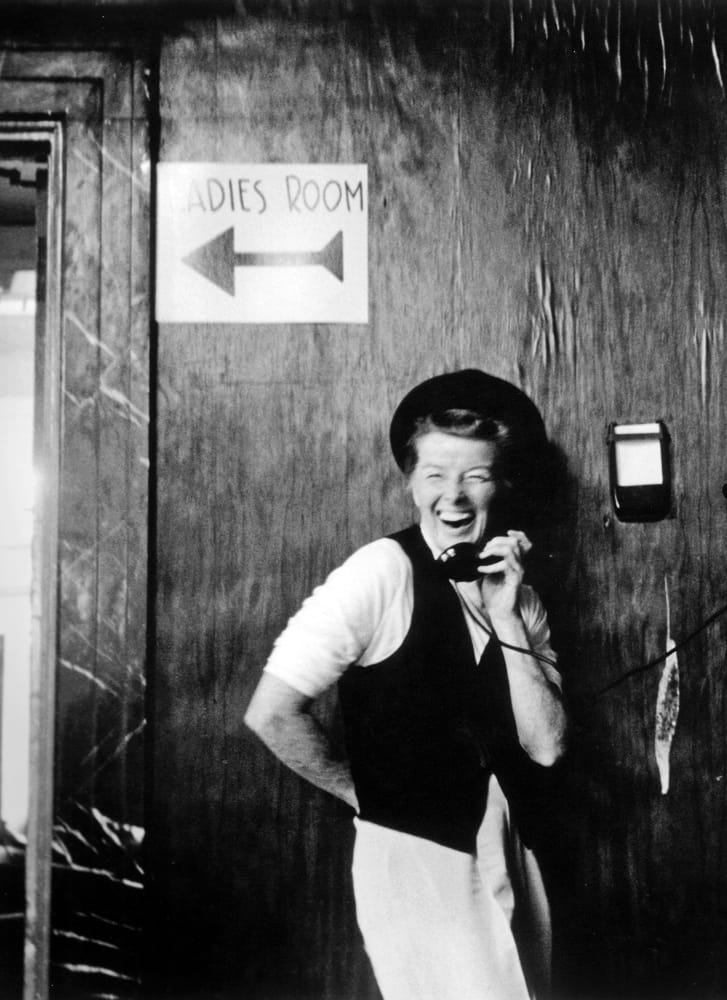
Susan Ware makes the astute observation that Hepburn ‘remained one of the few actresses who was ever allowed to sacrifice love for career.’ This unique position in Hollywood's constellation of stars enabled her to anchor films that would have been impossible with other actresses of the era.
Building the revolutionary star text through early films
Hepburn's persona developed through a series of films featuring autonomous and powerful women. In Christopher Strong (1933), directed by Dorothy Arzner, she played a female aviatrix who commits suicide when she discovers she's pregnant by her lover. She played Jo March in Little Women (1933) and portrayed Mary, Queen of Scots in Mary of Scotland (1936). In A Woman Rebels (1936) she plays an early feminist with an illegitimate daughter whom she raises as her niece. Hepburn's character spends half of Sylvia Scarlett (1935) dressed as a boy when she and her father are trying to evade the authorities.
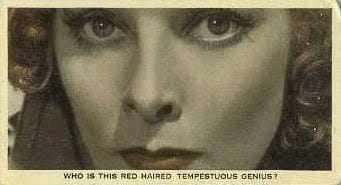
All of these roles contributed to Hepburn's star text as the ‘red-haired tempestuous genius.’ Her particular brand of female independence had been accepted by the general public to the point that it became something attractive rather than repulsive. Therefore, the film text becomes able to portray communities which highlight this new type of empowerment because her star text has already proved its possibility and potential.
Little Women: The foundational community of women
Little Women presents an archetype of the ‘communities of women’ structure. The plot centres on a group of women living relatively independently whilst their father is away at war. Hepburn's character Jo rejects the sentimentality and femininity society imposes on young women and instead embraces the traditionally masculine characteristics of strong language, outspoken opinions, and ambition for professional success.
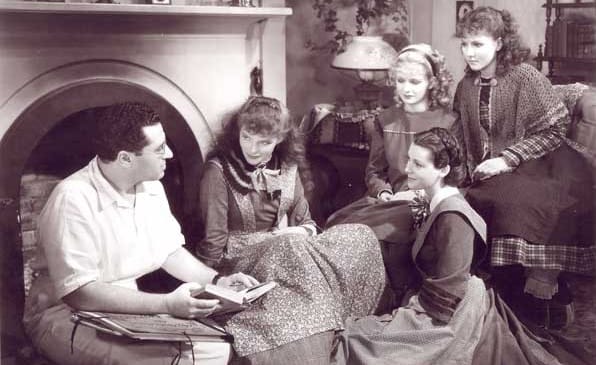
"I didn't have to direct her; she directed herself. She is Jo. Of all the characters she ever played, it is the one who is closest to Kate herself. Kate and Jo really are the same girl." (Little Women director George Cukor)
Jo's relationship with the male lead, Laurie, remains that of a brother and sister, although he approaches her romantically. Jo rejects Laurie not because she doesn't love him but because she is more interested in her career and her relationship with her sisters than in marriage. This prioritisation of female relationships over heterosexual romance becomes a defining characteristic of the Communities of Women film.
Stage Door: Professional women creating alternative family
Stage Door (1937) represents one of the most complete expressions of the ‘communities of women’ concept. The film centres on a group of career women at the Footlights Club, exceptions from traditional gender roles who drive the plot. The community of women consists of a camaraderie which provides support to its members in lieu of a heterosexual partner. The women give each other the support denied them by traditional gender guidelines.
The women take care of each other within the home, like when they ensure Kay gets enough to eat even though she cannot afford her keep anymore. Their banter provides an atmosphere conducive to bolstering their morale. The two sexes appear in direct opposition: the women are at a definite disadvantage professionally to the men, who are blocking their careers. Therefore, the women find strength in numbers when dealing with the opposite sex.
"You mustn't mind the girls; they're just full of fun. We're like one great big family."
Katharine Hepburn's character Terry stands out from the minute she walks into the boarding house with her neatly tailored suit, Bryn Mawr accent, and her comment, ‘You mean meals are included in the fourteen dollars?’ She has the class, money, and upbringing that the other women have grown to despise. These signs of conventional success represent the society which has been oppressing them.
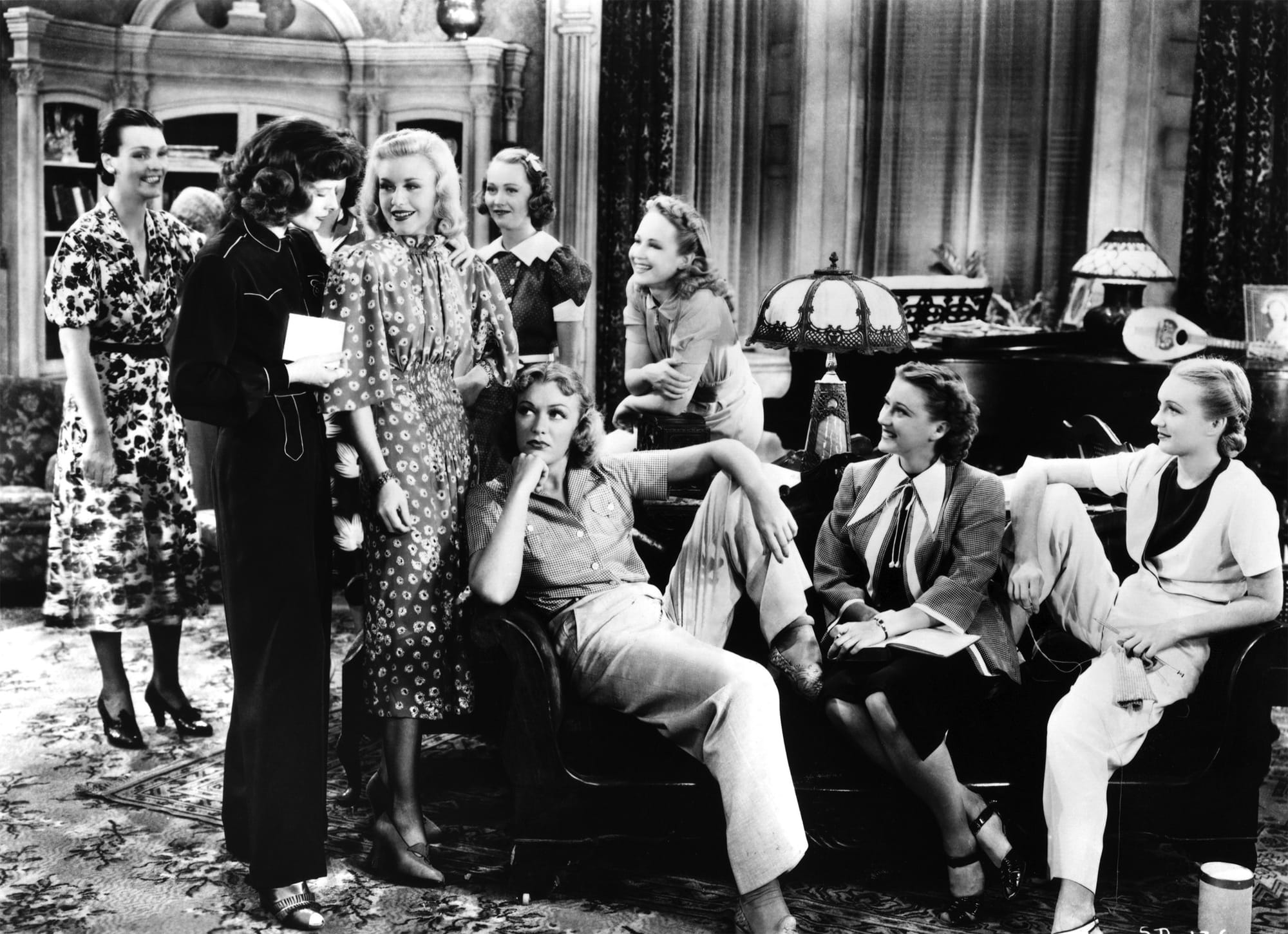
The unique aspect that sets Terry apart is that she most obviously has the choice not to have an acting career. Her alternative choices seem much more desirable to the other women than being an actress, which creates tension within the community. Her choosing to detach herself from her father's clutches represents an ideological shift toward autonomy and independence from men.
Desk Set: Evolution of women's professional communities
Twenty years later, Desk Set (1957) demonstrates how the relationship between women and society has changed marginally. This group of professional women has become more integrated into society because they work in a large company containing both men and women. However, whilst the office building contains both male and female professionals, the female professionals have been departmentalised into the research department.
Bunny: Well, there's my job. I can't just walk out.
Mike: I'm a vice president. I hereby transfer you to the west coast to take care of me! Anything else?
Bunny: What about the girls, Mike? I can't just leave them, just leave them. Not when they're so worried about their jobs.
Mike: Sorry. I can't help you there. I don't propose to take them on my honeymoon! But, they're all invited to visit us next summer when we have our own house.
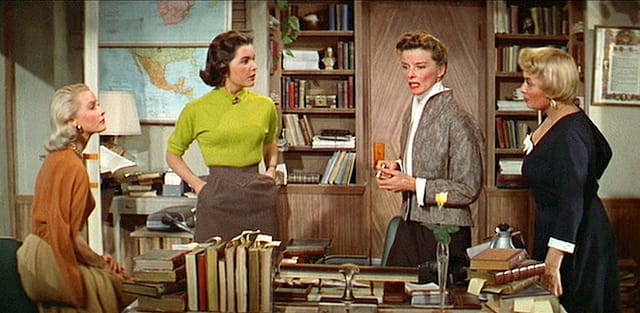
The combined star text of the Spencer Tracy/Katharine Hepburn alliance mediates the complications of the 1950s film about a community of women. The women in Desk Set represent an established group of friends, whilst the actresses in Stage Door always remain slightly suspicious of one another. The atmosphere in the later film suggests that the women have worked hard to maintain their autonomy in society.
The youngest member of the female group, Ruthie, has more choices than the others because of her youth. She might order a dress over the phone, showing interest in her appearance, yet she also offers to stay overtime for extra work, arguing that ‘It was hard enough getting this job and I want to keep it.’ There is a subtle connection between her and Miss Watson, with Miss Watson as the most senior member of the group and Ruthie as her protégé.
Quality Street, The Madwoman of Chaillot, and The Trojan Women
The ‘communities of women’ structure extends to other less well-known Hepburn films. Quality Street (1937) features an incredibly young spinster Hepburn running a school with her sister. The Madwoman of Chaillot (1969) presents a group of eccentric women standing up to Parisian corruption. The Trojan Women (1971) adapts Euripides' tale of the conquered women of Troy.
These films demonstrate the flexibility of the communities of women concept across different genres and time periods. Each presents groups of women whose primary relationships and concerns centre on one another rather than on heterosexual romance or male approval.
Departmentalisation and the exceptional woman
The communities of women in these films occupy a unique departmentalised position in relation to the society in which they function. In Stage Door, the community remains almost completely separate from the rest of society; the actresses, because of their choice of profession, are exceptions to traditional gender roles, although not entirely exempt from societal pressures.
The women cannot be married and act at the same time, nor can Hepburn's character be a daughter and an actress simultaneously. Their relationship to society is one of complete marginalisation. Because they reject the traditional heterosexual relationship structure, they must find a substitute for what that structure fails to provide - professional support supplemented by the energies of the female group.
The Role of Female Collaborators Behind the Camera
Significantly, many of these films that featured strong communities of women were produced by female collaborators behind the camera. Christopher Strong was both written and directed by women: Zoe Akins wrote the screenplay and Dorothy Arzner directed. Both Stage Door and Desk Set were written by husband-and-wife teams that included women: Edna Ferber and George Kaufman for Stage Door and Phoebe and Henry Ephron for Desk Set.
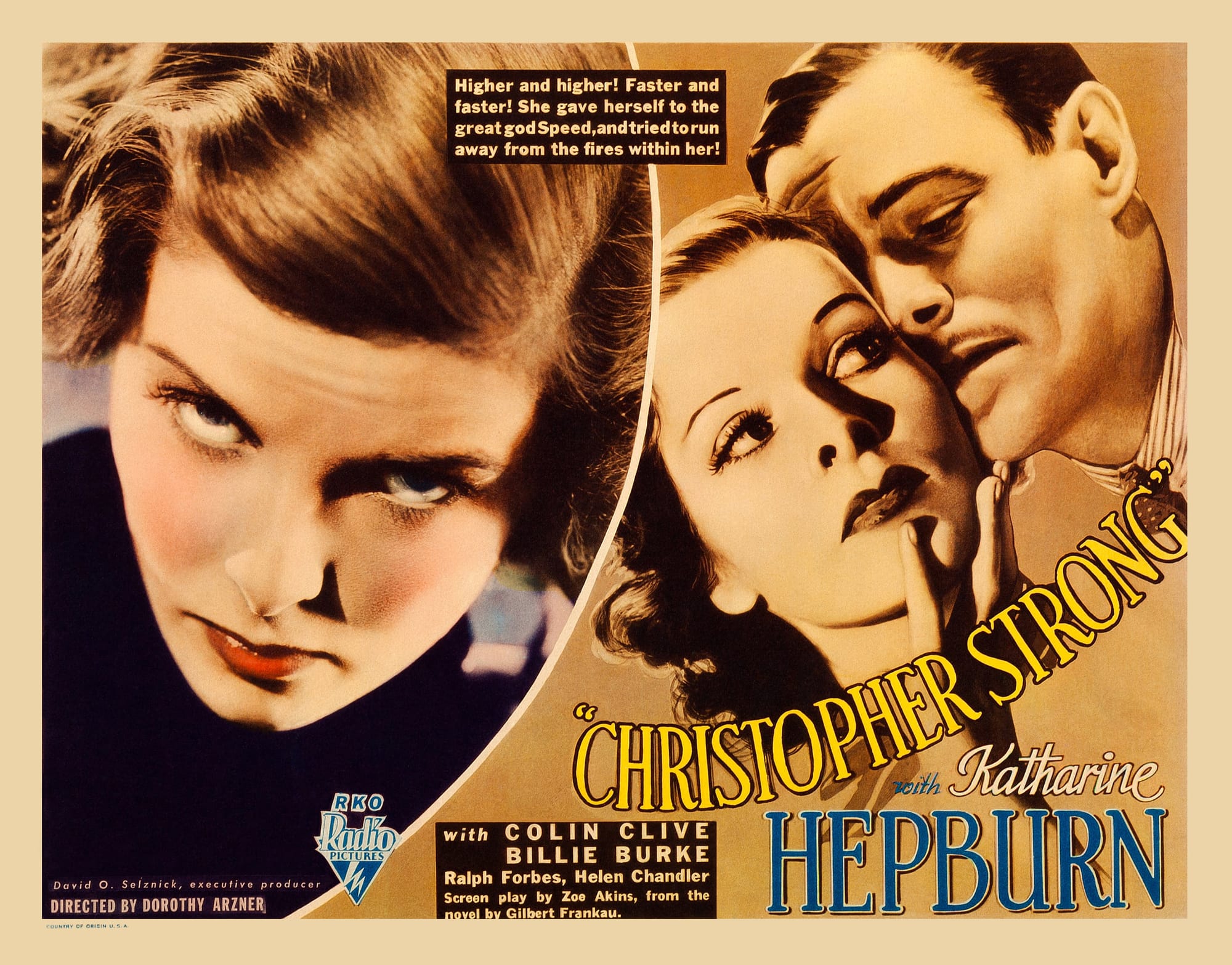
Susan Ware notes that ‘most of the women prominent in these areas in the 1930s were holdovers from the 1910s and 1920s’ and that ‘Once production was centralised in larger and larger conglomerates, such as Metro-Goldwyn-Mayer or Twentieth Century Fox, women's talents were easier to pass over.’
"She wore pants. So did I. We had a good time working together." (Hepburn on working with Dorothy Arzner)
The presence of these women as co-authors contributes to the theme of communities of women, creating concentric circles of community in which these stories are couched. This collaborative approach mirrors the supportive relationships depicted on screen.
Legacy and influence on modern cinema
Modern films like Thelma and Louise (1991) demonstrate the continued relevance of narratives centring on female relationships and autonomy. The Bechdel Test has brought renewed attention to the lack of realistic female relationships on screen, highlighting how the communities of women structure seen in classic film addressed ( or completely bypassed) these concerns decades earlier.
These films prove that communities of autonomous women have a place in society if the text of the central character makes them acceptable to that society by way of being exceptions. Hepburn's popularity as an exception supports the acceptance of these groups in a way that necessitates their existence.
Conclusion: The enduring power of female community
The communities of women in Katharine Hepburn's films represents a revolutionary approach to female representation in cinema. Through her unique star persona, Hepburn enabled filmmakers to create narratives that centred on women's relationships with one another rather than their relationships with men. These films demonstrated that autonomous women could drive compelling narratives whilst challenging traditional gender roles.
As George Cukor, a good friend of Hepburn who directed her in ten films across her career, once observed:
‘Kate is the most eccentric person I know. And the most eccentric thing about her is she thinks she's regular.’
Perhaps this perception of regularity in her eccentricity represents what all twentieth-century women aspired to - the normalisation of female autonomy and the strength found in communities of women supporting one another's professional and personal ambitions.
The academic principles underlying these ‘communities of women films’ continue to resonate in contemporary discussions of female representation in cinema, demonstrating the enduring power of Hepburn's revolutionary star persona and its lasting impact on film history.
Works cited
Britton, Andrew. Katharine Hepburn: Star as Feminist. New York: Columbia University Press, 2003. Print.
Christopher Strong. Dir. Dorothy Arzner. Perf. Katharine Hepburn. RKO Radio Pictures, 1933. Film.
Desk Set. Dir. Walter Lang. Perf. Katharine Hepburn. Twentieth-Century Fox, 1957. Film.
Kaledin, Eugenia. Mothers and More: American Women in the 1950s. Boston: Twayne Publishers, 1984. Print.
Little Women. Dir. George Cukor. Perf. Katharine Hepburn. RKO Radio Pictures, 1933. Film.
The Madwoman of Chaillot. Dir. Bryan Forbes. Perf. Katharine Hepburn. Commonwealth United Entertainment, 1969. Film.
Mary of Scotland. Dir. John Ford. Perf. Katharine Hepburn. RKO Radio Pictures, 1936. Film.
Quality Street. Dir. George Stevens. Perf. Katharine Hepburn. RKO Radio Pictures, 1937. Film.
Stage Door. Dir. Gregory La Cava. Perf. Katharine Hepburn. RKO Radio Pictures, 1937. Film.
Sylvia Scarlett. Dir. George Cukor. Perf. Katharine Hepburn. RKO Radio Pictures, 1935. Film.
Thumin, Janet. "'Miss Hepburn Is Humanized': The Star Persona of Katharine Hepburn." Feminist Review 24 (Fall 1986): 71-102. Print.
The Trojan Women. Dir. Michael Cacoyannis. Perf. Katharine Hepburn. Cinerama Releasing Corporation, 1971. Film.
Ware, Susan. Holding Their Own: American Women in the 1930s. Boston: Twayne Publishers, 1982. Print.
---. "Katharine Hepburn: Her Mother's Daughter." History Today 40.4 (1990): 47-53. Print.
A Woman Rebels. Dir. Mark Sandrich. Perf. Katharine Hepburn. RKO Radio Pictures, 1936. Film.





